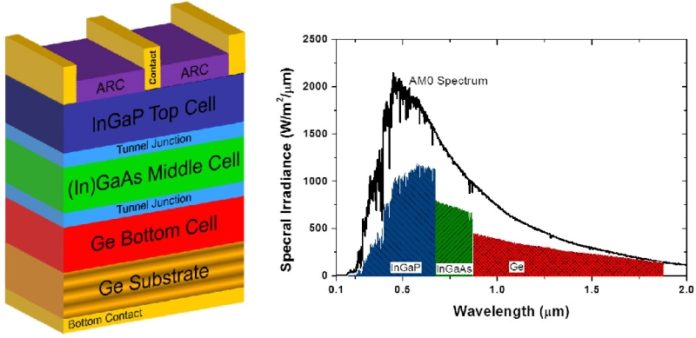Welcome to “Tuesdays with Scott” segment of the Climate Change program.
Last Tuesday, I discussed how second generation solar cells, though cost-competitive, nearing crystalline silicon efficiency with lower carbon footprint, are losing market share to conventional solar cells.
Today, I explore multi-junction (MJ) photovoltaic cells that are neither first or second generations. Multi-junction solar cells have multiple p-n junctions made of different semiconductor materials to produce an electric current in response to different wavelengths of light. A typical triple junction semiconductor is made of indium gallium phosphide (InGaP), indium gallium arsenide (InGaAs) and germanium (Ge). The use of multiple semiconductor materials enables a broader range of wavelengths to be absorbed, thus increasing efficiency. The theoretical efficiency of multijunction solar cells is 86.8 percent for an infinite number of p-n junctions. Lab tests have shown performance over 46 percent efficiency under concentrated sunlight. Commercial multi-junction and tandem cells have an efficiency of about 30 percent under sunlight and around 40 percent under concentrated sunlight.
The downside of multi-junction PV cells has been costs. The efficiency comes at the cost of increased complexity and manufacturing costs. This has limited solar PV market share, mostly limited to concentrator PV (CPV). Unlike conventional PV solar farms, CPV uses lenses or curved mirrors to focus sunlight onto small, highly efficient, multi-junction solar cells. In the near future, high concentration PV (HCPV) possess the highest efficiency of all existing PV technologies. The International Energy Agency sees potential to increase the efficiency of CPV to 50 percent efficiency by mid 2020s. The levelized cost of electricity is in the range of $0.08 to $0.15 per kWh and installation cost for a 10-megawatt CPV power plant between $1.50 to $2.30 per watt-peak.
HCPV competes with concentrated solar power (CSP) that’s most suitable for high direct normal irradiance along the Sun Belt region or south of the 36th parallel in the U.S. and the sun belt lying between Valencia in the west and Genoa in the east along the coast of the Mediterranean Sea that’s also referred to as the Golden Banana in Europe. CSP uses the heat from the sun’s radiation to make steam to drive a turbine that then produces electricity using a generator. As of 2012, CSP is still more common than CPV.
Overall, multi-junction, though higher in efficiency than first and second generation solar cells, is more expensive and as such multi-junction PV cells have been primarily applied in aerospace whereas crystalline silicon cells have been used for terrestrial, on the ground applications.
Next Tuesday, I explore third generation solar cells.
Don’t forget to subscribe to Climate Change with Scott Amyx on Amazon Alexa and give it a 5-star rating.


















